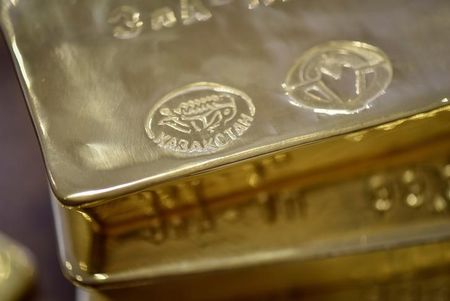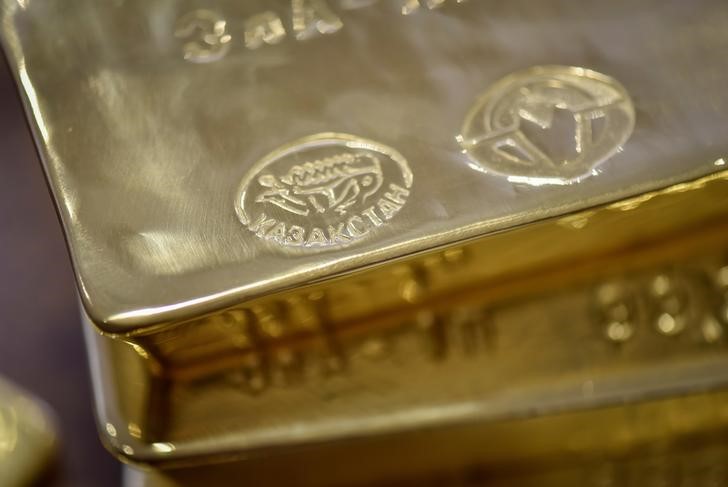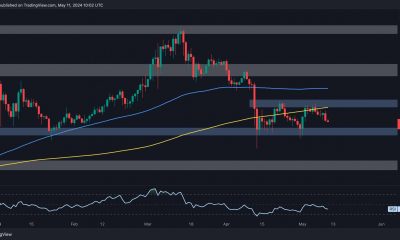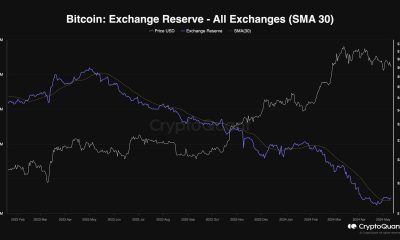Commodities
Gold prices steady ahead of payrolls report, copper boosted by China


© Reuters.
Investing.com– Gold prices moved little on Friday, steadying near three-week highs as markets awaited more cues on U.S. monetary policy from nonfarm payrolls data due later in the day, while copper prices rose on positive Chinese factory data.
The yellow metal had a strong run-up this week as a string of weak U.S. economic readings spurred bets that the Federal Reserve will keep rates on hold in September, which in turn dented the .
But the greenback rebounded on Thursday after data showed – the Fed’s preferred inflation gauge- remained sticky in July, while grew more than expected. This saw gold consolidate some weekly gains.
steadied at $1,940.14 an ounce, while expiring in December were flat at $1,966.55 an ounce by 00:59 ET (04:59 GMT). Both instruments were still trading up between 1% and 3% for the week.
Nonfarm payrolls keep markets on edge
Focus is now squarely on data for August, due later in the day. While the reading is expected to have weakened from the prior month, markets still remained on edge over any potential upside, given that payrolls have consistently beaten expectations so far this year.
Any signs of strength in the labor market, coupled with sticky inflation, gives the Fed more headroom and impetus to keep interest rates higher. While the central bank may not hike rates in September, it is still expected to .
Rising rates had battered gold through the past year as the opportunity cost of investing in non-yielding assets increased. The yellow metal’s near-term prospects are also dimmed by rates likely remaining higher for longer.
Stronger-than-expected data also pointed to higher rates in other major economies.
But gold may still see some strength this year if global economic conditions worsen amid high rates. Recent U.S. data showed that the world’s largest economy was now cooling, despite defying a recession in the first half of the year.
Copper boosted by China PMI, stimulus
Among industrial metals, copper prices rose on Friday, tracking a private survey that showed China’s unexpectedly grew in August.
The reading somewhat complemented from Thursday which showed that China’s manufacturing sector was edging towards expansion territory, although the official reading still showed contraction in the sector.
Still, the private survey, coupled with more stimulus measures from Beijing, helped improve sentiment towards the world’s largest copper importer. China announced looser mortgage requirements for its property sector, and also began to increase local liquidity.
rose 0.5% to $3.8525 a pound, and were set to add 2.4% this week.
Commodities
Oil falls on prospect of higher-for-longer US rates, stronger dollar

By Laila Kearney
NEW YORK (Reuters) -Oil prices fell by nearly $1 a barrel on Friday as comments from U.S. central bank officials indicated higher-for-longer interest rates, which could hinder demand from the world’s largest crude consumers.
futures settled at $82.79 a barrel, down $1.09, or 1.3%. U.S. West Texas Intermediate crude settled at $78.26 a barrel, down $1.00, or 1.3%.
For the week, Brent logged a 0.2% loss, while WTI recorded a rise of 0.2%.
Dallas Federal Reserve President Lorie Logan on Friday said it was unclear whether monetary policy was tight enough to bring down inflation to the U.S. central bank’s 2% goal.
Higher interest rates typically slow economic activity and weaken oil demand.
Atlanta Fed President Raphael Bostic also told Reuters he thought inflation was likely to slow under current monetary policy, enabling the central bank to begin reducing its policy rate in 2024 – though perhaps by only a quarter of a percentage point and not until the final months of the year.
“The two Fed speakers certainly seemed to put the kibosh on the prospect of rate cuts,” said John Kilduff, a partner at Again Capital.
The U.S. dollar strengthened after the Fed officials’ comments, making greenback-denominated commodities more expensive for buyers using other currencies. Higher-for-longer U.S. interest rates could also dampen demand.
Oil prices were also under pressure from rising U.S. fuel inventories approaching the typically robust summer driving season, said Jim Ritterbusch of Ritterbusch and Associates.
“Given the price decline of the past month and the weaker-than-expected demand trends for U.S. gasoline and diesel, some bearish demand adjustment would appear likely,” Ritterbusch said.
remove ads
.
Next week, U.S. inflation data could influence Fed decisions on rates.
Oil drew little support from the U.S. oil rig count, which is an indicator of future supply, despite energy services firm Baker Hughes data showing the number of oil rigs fell by three to 496 this week, their lowest since November. [RIG/U]
Money managers, meanwhile, cut their net long futures and options positions in the week to May 7 by 56,517 contracts to 82,697, the U.S. Commodity Futures Trading Commission said.
Data on Thursday showing China imported more oil in April than the same month last year also helped keep oil prices from moving lower. China’s exports and imports returned to growth in April after contracting the previous month.
The European Central Bank, meanwhile, looks increasingly likely to start cutting rates in June.
In Europe, a Ukrainian drone attack set an oil refinery in Russia’s Kaluga region on fire, RIA state news agency reported on Friday, the latest salvo from Kyiv in what has become a series of tit-for-tat attacks on energy infrastructure.
Conflict in the Middle East also continues after Israeli forces bombarded areas of the southern Gaza city of Rafah on Thursday, according to Palestinian residents, after a lack of progress in the latest round of negotiations to halt hostilities in Gaza.
Commodities
This indicator says oil prices will bottom soon: analysts

Oil prices are set to form a bottom in the coming months, McClellan Financial Publications analysts argue.
Recent gold price trends, adjusted forward by 19.8 months, can be compared to prices, a shift that aims to highlight how gold’s price movements tend to echo in oil prices after that specific interval.
While not a flawless model, it generally provides strong accuracy, the report states. Occasionally, discrepancies occur, such as when Russia’s invasion of Ukraine disrupted the oil market. However, after each such divergence, prices consistently strive to realign and return to their historical correlation.
“Coming up, this model says that we have a bottom due in mid-2024, followed by a rise toward the end of the year,” The McClellan Market Report says.
“That oil price rise is not going to be good news for any federal politicians who may be running for reelection in November. And if the recent rally in gold prices (just off the right end of this chart) keeps going higher, that is going to mean higher oil prices 19.8 months later,” it added.
In late 2023, crude oil prices declined earlier than expected, missing the predicted peak that gold price movements had indicated would occur later that year. However, oil prices have since realigned with the pattern, the report highlights.
The forecast indicates that the forthcoming bottom will ideally occur around June or July 2024. That said, it’s worth noting that turning points might not precisely follow this timeline and could occur slightly earlier or later.
remove ads
.
The key takeaway is that a bottom is expected, though more price declines may occur before reaching that point.
“Then as summer gets closer, we should turn to other indicators to home in on signs that the price bottom for oil is arriving, and/or that an upturn is starting,” the report notes.
Commodities
Oil prices set for positive week on demand hopes, Middle East tensions

Investing.com– Oil prices rose Friday, on track for a positive week, after signs of demand growth in both the U.S. and China, while tensions remained strained in the Middle East.
At 08:40 ET (12:40 GMT), rose 0.5% to $84.26 a barrel, while gained 0.6% to $79.73 a barrel.
Oil heads for weekly gains
Both benchmark contracts were set to post gains of around 2% this week, boosted by stronger-than-expected overall data from China, the world’s biggest oil importer. Signs of strong domestic demand pushed up hopes that oil demand will start picking up in the Asian giant.
China’s oil imports added to the positive overall tone as well, as although imports fell from the prior month, they came in above the levels seen last year.
Additionally, inventories surprisingly fell last week, and refining and fuel demand is set to increase tracking higher travel demand during summer.
“EIA data shows that U.S .commercial crude oil inventories fell by 1.36m barrels over the last week, different to the 500k barrel build the API reported,” analysts at ING said, in a note.
“The decline in crude oil stocks was driven by stronger exports, which increased by 550kk b/d WoW to 4.47m b/d, and stronger refinery activity.”
Israel-Hamas ceasefire appears unlikely, tensions high
Israel has continued its assault on the South Gaza city of Rafah, even as Hamas said the assault largely undermined ceasefire talks.
The attacks persisted even as the U.S. said it will suspend weapon shipments to Israel over the Rafah strikes.
remove ads
.
The Rafah strikes pointed to sustained geopolitical unrest, resulting a risk premium remaining alive in crude markets, given that geopolitical unrest in the Middle East could potentially disrupt supplies from the crude-rich region.
OPEC+ to roll over cuts?
Also supporting prices this week has been talk that the Organisation of Petroleum Exporting Countries. and allies, known as OPEC+, will continue to roll over output cuts, in an attempt to limit global supply.
“OPEC+ members will also become uncomfortable if starts flirting with $80/bbl, a level which is not too far away,” ING added.
“As we have mentioned previously, price weakness increases the likelihood that OPEC+ members will fully rollover their 2.2m b/d of additional voluntary cuts into the second half of the year, which risks overtightening the market later in 2024, assuming no downside surprises on the demand side.”
(Ambar Warrick contributed to this article.)

 Forex2 years ago
Forex2 years agoForex Today: the dollar is gaining strength amid gloomy sentiment at the start of the Fed’s week

 Forex2 years ago
Forex2 years agoHow is the Australian dollar doing today?

 Forex1 year ago
Forex1 year agoUnbiased review of Pocket Option broker

 Forex2 years ago
Forex2 years agoDollar to pound sterling exchange rate today: Pound plummeted to its lowest since 1985

 Cryptocurrency2 years ago
Cryptocurrency2 years agoWhat happened in the crypto market – current events today

 World2 years ago
World2 years agoWhy are modern video games an art form?

 Stock Markets2 years ago
Stock Markets2 years agoMorgan Stanley: bear market rally to continue

 Economy2 years ago
Economy2 years agoCrude oil tankers double in price due to EU anti-Russian sanctions

































